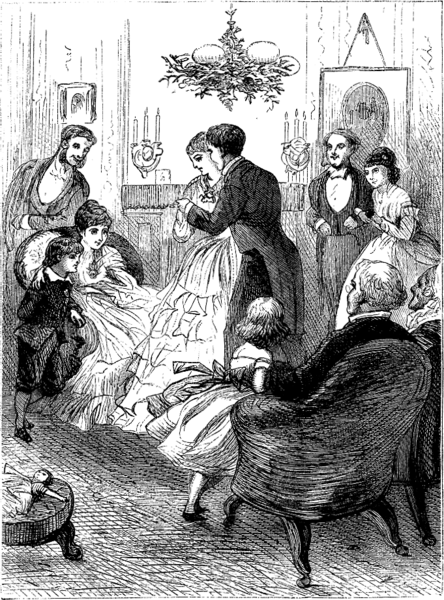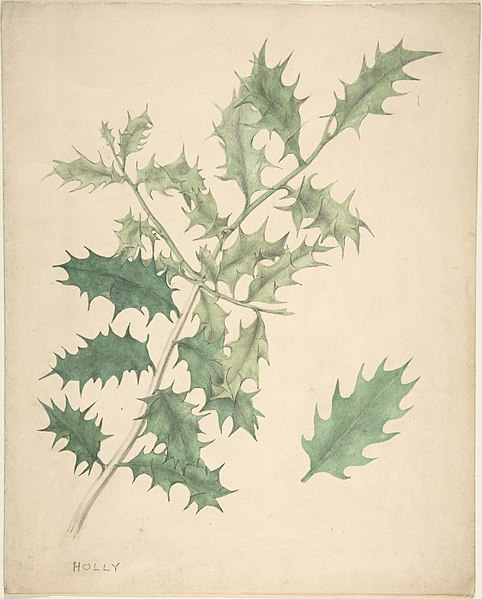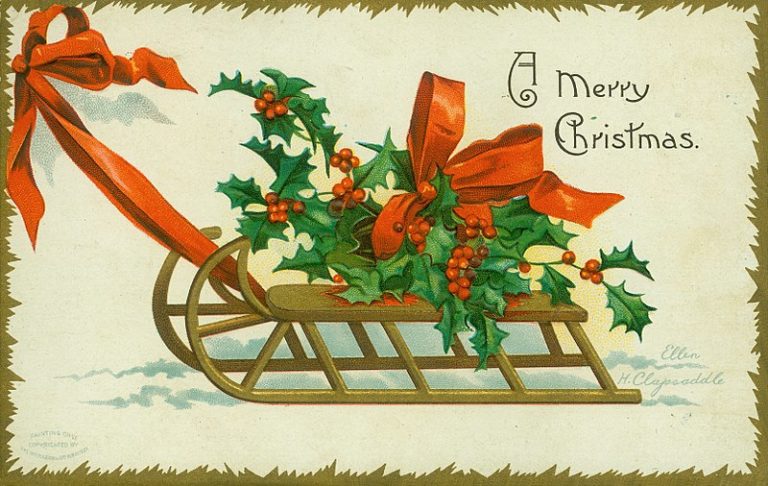Templa Exornantur: Mistletoe & Holly
Mistletoe is central to many ancient traditions. Most notably, that of the Druids.
Pliny the Elder wrote in his "Natural History" at length about a particular practice called the Ritual of the Oak and Mistletoe. According to this account, it occurred on the solstices.
The Druids scaled an oak tree, cut down the mistletoe hanging from it with a golden sickle, slaughtered two white bulls whose horns had never before been bound, and created a concoction from the mistletoe that was supposed to cure sterility, as well as act as an all-inclusive antidote to poisoning.
And since mistletoe lived all year while the sacred oak it grew on appeared to die, it signified immortality and as evidenced above, fertility.
The kissing tradition is a tough one to pin down.

"Under the Mistletoe," 1873.
Mistletoe is rife with fertility symbolism, from its nature as an aphrodisiac to its berries to the fact that it is a semi-parasitic plant, which means that whenever it's found, it's attached to another tree.
That, of course, implies coupling, and this fact may have been what led to it being used in marriage ceremonies and festivals in Greece and Rome, as well as the aforementioned Druidic associations.
It was, all in all, a sacred plant. Even Aenaes's golden bough, which he carried to the Underworld, was mistletoe. Some have even proposed that the little x's at the bottom of the berries (pictured) were first associated with a kiss because of mistletoe.
Some associate the kissing with the Norse legend of the death of Baldr, god and son of Frigg, to whom mistletoe was a sacred plant.
Baldr was killed with a mistletoe arrow in a schemed concocted by Loki. In both the happy (Baldr's resurrected!) and sad (Baldr's left to Hel) versions of the story, Frigg declares that mistletoe must henceforth be known as a plant of love, and people kissed underneath it to honor her and keep memory of Baldr from dying.
There was also the Scandinavian custom of truce. If you were to happen upon this plant while in the woods, you and your foe both laid down your weapons beneath, and as time progressed, expressed a greeting of friendship.
But this was fairly secular practice for a long time.
Mistletoe was used as a door hanging as a protective charm against demons, witchcraft, fire, and overall bad luck. It was placed under pillows to induce dreams of omens.
Its first recorded use as an excuse to kiss was in England around the 1500s, though I cannot find the primary source. Reportedly, by the 1700s, it was popular custom of the servant/working class.
Tradition was that for every kiss, a berry was picked. No more berries, no more smooches. Any woman who refused a kiss under the mistletoe was cursed to receive no proposals, or become an old maid.
And then Washington Irving and Charles Dickens, henceforth and forever known as the Literary Grandaddies of Holidays As We Know Them, made sure it stuck around.
Irving wrote in 1820 about the kissing tradition in "Christmas Eve," from his work, The Sketch Book of Geoffrey Crayon, Gent.
"Here were kept up the old games of hoodman blind, shoe the wild mare, hot cockles, steal the white loaf, bob apple, and snap dragon; the Yule-clog and Christmas candle were regularly burnt, and the mistletoe with its white berries hung up, to the imminent peril of all the pretty housemaids."
Excerpt from "The Sketch Book of Geoffrey Crayon, Gent." by Washington Irving, 1820.
"The Pickwick Papers," written by Dickens and published in 1836, is no less jovial.
Upon seeing the titular Mr. Pickwick lead an old woman underneath the "mystic branch" for the kissing ritual, the young and pretty girls in the room went all aflutter and "screamed and struggled, and ran into corners, and did everything but leave the room, until [the girls] all at once found it useless to resist any longer and submitted to be kissed with a good grace" after which "faces were in a glow, and curls in a tangle."

Illustration from "The Pickwick Papers" by Charles Dickens, circa 1881.
All this kissing for a plant whose name actually means "sh t on a stick". ("Mistel", dung; "tang", twig.) Because, you know, it's germinated through bird feces.
On to holly.

Illustration of holly leaves. Courtesy of the Metropolitan Museum of Art.
Holly was also cherished by the Druids, whose winter solstice celebrated god-twins the Oak King (the transient tree whose leaves fall) and the Holly King (perennial, who when the Oak King dies, can be seen amidst the dead branches.)
Druids and Celts also wore braided holly crowns on special occasions and their signature winter festivals, as did the Romans.
The Celts also adorned their doors with it or otherwise brought it indoors due to its associations with fairies and sylvan sprites--some claim to welcome them in, others say to act as "fairy flypaper" and trap them out.
Holly is well-known for its practical protective uses, and the remnants of its utility as a protector of deer parks and garden estates is still found in the names of the same: Holly Oaks, Hollywood, Hollins. It was often planted around valuable or aesthetically outstanding plant species to protect them from grazing fauna.
It's easy to see, then, why it was also commonly used in representations of honesty and fidelity. Henry VIII even wrote a love song titled "Green Groweth the Holly" about how stalwart and loyal he is to his lady love.
Irony.
Eventually, the Church co-opted holly, claiming the sharp leaves represented Jesus's crown of thorns, and the red berries were His blood. Holly is also considered a "male" plant, where ivy is its female counterpart, which is the source material for the English carol "The Holly and the Ivy."
Decorating with holly and mistletoe is recorded in Britain, of course, and across the ocean in Virginia, where they shot mistletoe down from trees. Because it seems that where the Englishmen go, English customs perpetuate.
As evergreens, both plants symbolize immortality and coming spring in the dead of winter. And everlasting life, of course, easily translates to Christian canon. Early church calendars have found Christmas Eve notated as templa exornantur, meaning "the Churches are decked."

Christmas postcard circa 1907.
A brief PSA: no matter what the ancient cultures believed about healing properties, don't eat eat mistletoe or holly berries. They're supremely toxic.



